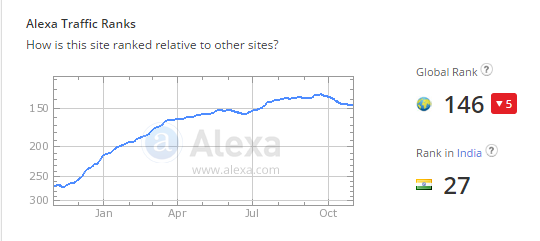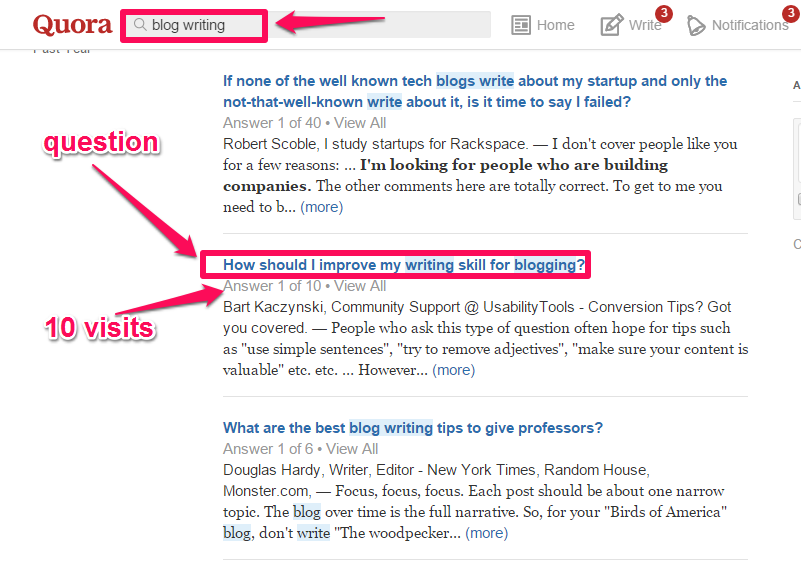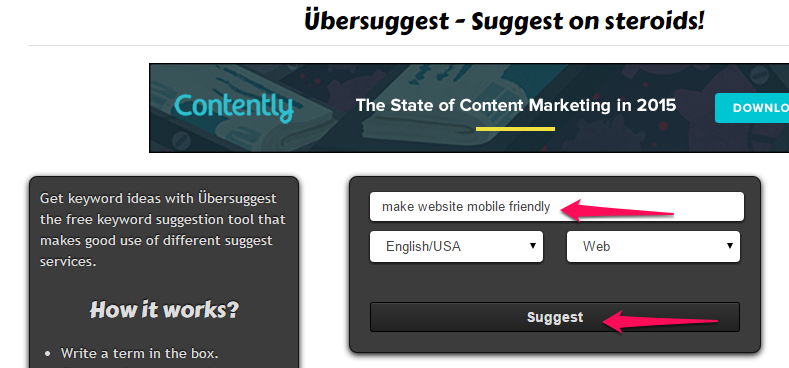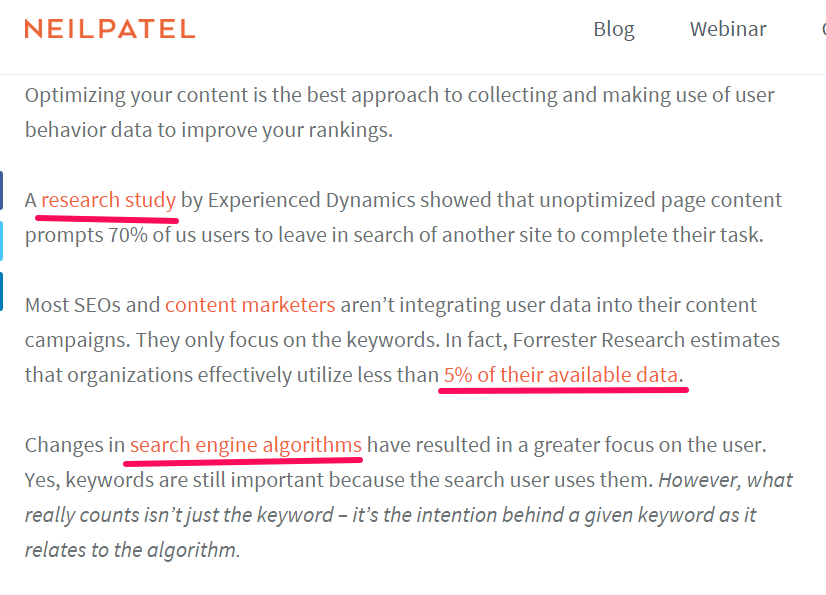If you want consistent organic traffic, then you’ve got to put a working system in place – better yet, an organic traffic “pipeline.”
A half-baked approach to search engine optimization only yields meager results in terms of driving organic traffic. I’m sure nobody wants that. I certainly don’t.
Every so often, you hear that relying on organic traffic is like playing the lottery. The odds aren’t in your favor, and it’s win or lose – mostly lose.
Come on!
No online business could exist without relying to some degree on search engines, especially Google. The people in your audience use search engines to look for information. According to Search Engine Journal, 70% of the links search users click on are organic.
No matter how much traffic you decide to buy through either native advertising or other media channels, one day you’ll need Google.
Search engines exist because people need the right information–and you want them to find yours easily. Optimizing for search users is one aspect of content marketing that just works.
When you add search engine optimization to your content marketing plan in the right way, the combination produces great results.
Even new bloggers are using content marketing to improve their organic search traffic and rankings.
Many experts – especially those who had terrible experiences with Google and its algorithm updates – believe that search engine optimization no longer works.
But it does work! You just have to approach modern SEO in the right way.
I want to prove it to you by sharing the 5 steps that you need to build a successful organic traffic pipeline.
So, let’s begin with the obvious:
Step #1: Hack user questions that you can use for keyword research.
“What do you do for a living?”
“Where do you work?”
Have you ever noticed that most conversations between strangers begin with a question? Questions and answers are the hallmarks of social living.
They’re also paramount to increasing organic traffic.
Every second, thousands of people go to Quora to ask questions. Quora was started in 2009 by the former CTO of Facebook and has become quite popular. According to Alexa, Quora has a global rank of 146.
The popularity of Quora makes it a great asset for marketers and content creators. You can hack user questions and leverage them in your keyword research.
Follow these simple steps to find trending questions on Quora:
Go to Quora, and plug your main keyword (e.g., blog writing) into the search box. Hit the “enter” button on your keyboard and look for questions that have received at least 10 answers.
Traditional keyword research might not show you an exact keyword like the question above. But, based on the search results, a lot of people are interested in this question – so answering it will probably help your readers.
You can also find keyword variations using that question. Just copy the question as it appears and plug it into the Google keywords tool:
Notice what we just did: we used one question with 10 answers on Quora to research some keywords. Building a successful organic traffic pipeline boils down to this: answering user questions.
So what should you do with these keywords?
Create compelling and keyword-rich titles with them.
Ideally, you should combine the Quora question with the keywords above to get the best of both worlds – that is, people asking the question in search engines and on social media will all be happy to read your content.
A suggested title for a future blog post, drawing on our examples above:
- Improving Your Writing: How Can I Advance My Writing Skills for Blogging?
Or, how about?:
- Better Writing Skills: How Should I Improve My Writing for Blogging?
- Improving English Writing Skills: How Should I Improve My Writing Skill for Blogging?
It’s true that most people search for “improving your writing” aren’t interested in blogging.
That’s why you should combine both the question and the keyword.
Of course, that’s not the end of it. You also have to produce high-quality content for those keywords.
Trust me, if you focus on creating content around questions that users have actually asked, you’ll consistently drive organic traffic.
Moreover, questions provide evergreen topics that you can address. Questions such as “what is the best way to start blogging?” will never stop getting asked. There will always be new bloggers who need to know.
Brian Dean, the founder of Backlinko, uses Quora to hack user questions and turn them into “wow” titles for his articles. A few months ago, he came across a popular question similar to this:
As a smart marketer, he created an in-depth blog post around that question. He used the Skyscraper Technique to promote the article. That single article has generated over 100,000 targeted leads and clients to his business.
Quora offers a unique advantage for your content by helping you find new angles to take. So, whenever you find a keyword using any research tool, it’s a good idea to use Quora to find question-based variations of it.
For example, the content marketing folks behind Canva found that the keywords related to “fonts” received nearly 800k monthly searches as a whole:
They couldn’t compete with authority web pages in the organic listings. So, instead of creating generic content about fonts, they dug deeper and searched for related questions on Quora:
The Canva team then created an in-depth, high-quality article targeting questions about “combining fonts.” The article generated over 5,000 shares on social media and drove thousands of design-centered visitors to the Canva site.
In my experience, the vast majority of those who ask questions on Quora aren’t experts. They’re entrepreneurs and professionals seeking solutions. So Quora has a targeted audience that, in turn, you can use to drive organic traffic.
RivalFox used Quora to answer questions related to competitive intelligence. This brought the right kind of traffic to their site and resulted in a conversion rate that was over 15% from visitor to trial.
So if you’re a blogger or content marketer, you can easily use Quora to find questions that you can answer and generate blog posts that will boost your search results.
Quora: What are the best examples of blog marketing, zeroing on tech-savvy people?
Compelling blog title: “Best Examples of Blog Marketing: 16 Tech-Savvy People Reveal Their Secrets”
Quora: Business case studies related to blog marketing and social media. What is the best source?
Useful blog title: “10 Best Sources Of Business Case Studies Using Blog Marketing And Social Media”
Quora user question: Are RSS feeds good for blog marketing?
Helpful blog title: “Are RSS Feeds Good for Blog Marketing? 10 Alternative Ways to Market Your Blog”
Remember that Quora isn’t just a “question & answer” site. It’s one of the most valuable resource sites for writers, researchers, search engine optimization consultants and digital entrepreneurs.
While others struggle to rank for their main keywords due to intense competition, you can stay ahead of the game by leveraging Quora’s user questions to write high-quality content.
Step #2: Research and target long-tail keywords (but don’t forget user intent).
Are you tired of people telling you that if you just write great content, people will visit your site and you’ll see a surge in organic traffic?
It’s actually true to some extent, but if you just sit around waiting for that organic traffic to arrive, you’ll wait forever. Getting thousands of organic visitors is much easier if you target long-tail keywords.
Long-tail keywords are three to four-word phrases that typically indicate that a user is close to purchasing or deciding on an action, whether that’s the “best place for tacos” or “singing lessons in Chicago.” They can be a hugely valuable avenue for increasing organic traffic.
After Google rolled out its Panda update, search engine optimization experts and bloggers embraced long-tail keywords because they drive the right kind of traffic.
Long-tail keywords help you connect with customers. When properly integrated into your blog posts, they can also help you drive 20,000 organic visitors to your site in under 6 months.
When you consider the top 100 – 500 keywords, including the ones that major brands target, long-tail keywords perform better than popular keywords.
You may not get a ton of traffic through long-tail keywords – they do have smaller search volumes on the whole than head keywords – but you’ll definitely generate targeted traffic. In search engine optimization, I think “targeted” traffic is better than “generic” traffic.
In my experience, long-tail search terms simplify search engine optimization and improve organic traffic. I’ve built 5 successful software companies, in part by combining both search engine optimization and content marketing to drive qualified customers.
In summary, long-tail key phrases are important if you’re looking to build a successful organic traffic pipeline.
You can use several tools to research long-tail search terms. I’ll show you some simple steps for using two popular keyword suggestion tools:
Step 1: Visit Google AdWords’ Keyword Planner. After logging in, plug in your main long-tail keyword (e.g., mobile-friendly website). Then scroll down to click the “Get ideas” button:
Step 2: Click the “Keyword ideas” tab to reveal all the keywords in each group:
Step 3: Pick keywords in the list that contain 4 or more words. These are the long-tail search terms that you can easily rank for.
The second free tool that can help you generate long-tail keywords is Ubersuggest. Just copy one of the keywords (e.g., from the screenshot above, make website mobile friendly). Plug it into the search box, then click the “suggest” tab.
Here are the long-tail keyword variations returned for our example:
Armed with these long-tail keywords, you’re ready to craft compelling titles.
However, remember that Google isn’t as concerned with keywords as it is with user intent. Don’t just stuff keywords into your blog post–it’s an outdated search engine optimization practice. Instead, focus on providing useful and engaging content for the user.
Step #3: Find winning headlines and make yours better.
The explosion in content is competing for your readers’ attention.
Each day brings over 400 million tweets. 294 billion emails are sent each day. 2 million blog posts and over 860 hours of videos are created daily.
You can either draw readers in with your headline or lose them. So, you need to learn how to write headlines that people want to click, share on social media, and ultimately increase organic traffic to your site.
One of the things that made Upworthy one of the fastest-growing media companies ever is their captivating headlines.
Headlines are vital. While 80% of people will read the title of your blog post, only 20% will read the rest. A user-optimized title can increase conversions by 500%.
It breaks my heart when I see a blog post headline that’s been optimized with keywords – but doesn’t offer anything useful to the actual reader.
Indeed, this is one of the worst search engine optimization practices I see. You’ve got to remember that Google’s just a search algorithm – albeit an important one. But, your prospects and customers are human beings who want to find web pages that will help them, not boost your search traffic.
So it’s time to start writing for people – they’re the ones who’ll subscribe to your list, click your links, buy your products and help spread the word about your brand on social media. Search engine bots can’t do any of those things.
You may not be a professional copywriter, but don’t let that stop you from writing titles that grab attention. Simply find winning headlines – i.e., those that have gone viral in the past – and model them.
You can craft a better headline when you understand your audience better than your competitors do.
You can find winning titles for your content in lots of places. I personally use BuzzSumo to find headlines that have received the most social media shares.
Here’s how:
Go to BuzzSumo. On the homepage, input your main keyword phrase (e.g., SEO tips) into the search box. Click the “Search!” button on the far right.
The viral blog post titles are:
- 5 Unusual Tips to Improve Your SEO With Social Media
- Computers and Their Importance: Best SEO and Blogger Tips Tricks for New Learner
Let’s model these viral headlines, and create better ones for our blog posts:
- 13 Unusual SEO Tips to Improve Your Organic Traffic
- Best SEO Tips for Bloggers: The Definitive Guide
Note that when writing a title, there are simple things that you can do to improve its value.
For example, when you include odd numbers, one study shows you’ll get a 20% higher click rate.
To maximize the organic click-through rate, your title should not exceed 60 characters. And, to the extent possible, add the main keyword at the front of the title (i.e., begin with it):
Ensure that your long-tail keyword flows smoothly with the rest of the title. Notice how my targeted long-tail keyword (“content marketing case studies”) reads smoothly in the title. If I hadn’t told you, you may not have even noticed it’s a search term.
You can also use online publications (e.g., magazines, newspapers and journals) to hunt for winning titles you can model.
Each magazine cover has compelling titles, written by professional direct response copywriters. These titles have been tested and proven to draw people into the content.
Follow these simple steps to find title ideas from magazine covers:
First step: Go to Magazines.com. Input your main keyword (e.g., fitness) into the search box on the right side.
Second step: Select your favorite magazine. From the list of fitness magazines, pick one and click on it. Study the magazine cover and find title ideas.
Third step: Study the strongest titles on the cover. Magazines usually contain strong and captivating titles. Your task is to study them, figure out what makes the titles attractive, and then create a better one.
Let’s identify the strongest titles in this issue of Cooking Light:
The strongest titles above are:
- Super Fast! Every Recipe in 25 Minutes or Less
- 78 Speedy Recipes
Since these headlines have generated thousands of subscriptions, we can improve the results from our content by using them as models, then integrating the right keyword phrases.
Let’s do it:
- Super Fast! How to Write a 1000-Word Blog Post in 2 Hours or Less
- 78 Speedy Recipes to Find Blog Post Ideas to Drive Organic Traffic
Step #4: Research your topic, then approach it from a unique angle.
Consistently writing useful and practicable content isn’t easy. 57% of marketers struggle to produce enough content that engages people.
And yet, it’s one of the driving factors for increasing organic traffic.
One way to utilize content for your organic traffic pipeline is to research your topic before writing your content, then put your own unique spin on the topic.
I know that you face a lot of competition in your niche – so do I. But you can still build a successful online business and boost your search traffic if you learn how to write content in your own voice.
In other words, approach your topic from a fresh angle.
How does this work?
Well, let’s say you’re an email marketer. I can assure you that thousands of articles, videos, podcasts, blog posts, ebooks, and online courses have been created on the subject of email marketing already.
That thought might terrify you – after all, what’s left to write about?
What you have to do is find an angle that hasn’t been “done to death.”
So, back to the example: If people are writing about “building an email list,” but you can’t find many data-driven posts, or there aren’t many infographics in all that content, there’s an opportunity you can explore.
Or, if you discover that your competitors are mostly writing blog posts, you could use a different approach – say, create advanced guides like I did.
I noticed there were tons of blog posts on personal branding and realized I didn’t want to just add to the noise.
So, I took a different approach. With the help of Aaron Agius, we authored “The Complete Guide To Personal Branding”:
I currently rank number #1 for the head keyword “personal branding” on Google. The guide has been shared thousands of times and authority links are pointing to it. One of the biggest reasons why that guide is so popular is because of the amount of research that went into it.
If you truly want clients to take your content seriously, go beyond personal opinions – especially when you’re starting out. Instead, challenge every assumption behind your opinions, then research extensively.
In other words, don’t just assume – find the data to back up those opinions.
Of course, if you’re an authority or an influential blogger, you can afford to be a bit more creative.
For example, Brian Dean invented several marketing concepts that are catching on – not because he gave them fancy names, but because they generate great results:
- “Content upgrades” (primarily used to collect email leads)
- “Skyscraper technique” (a new approach to writing blog posts that get shared)
- “Do the opposite strategy” (In search engine optimization, people often tell you to update your blog with new content to drive organic traffic. Brian advises writing less often but making sure each piece is powerful, then working your butt off to promote it)
Let’s see another example. What would you write about in this keyword?
Local SEO Strategy
Most people would simply write a blog post on how to develop a local search engine optimization strategy. A few others might share some tips on local SEO strategies that work.
If I were to write an in-depth blog post related to the keyword, I’d be more likely to use any of these titles:
- Local SEO Strategy: A Case Study of 5 B2B Companies and How They Did It
- 9 Simple Steps You Can Use to Develop a Local SEO Strategy Fast
- Local SEO Strategy: How to Drive Local Visitors to Your B2C Website
When you look for a unique angle, you don’t have to worry about competitors. Even if they’ve written extensively on every topic or keyword in your industry, you can still create great unique content for your customers and increase organic traffic to your site.
First, you need research – studies, statistics, trends, and data – to reference, especially if your topic is related to internet marketing.
A great place to start for internet marketing-related topics is this list of HubSpot marketing statistics, which has sections for search engine optimizaiton, email marketing, social media marketing, writing blog posts and lead generation stats.
But statistics aren’t enough. If you want to create top-notch content that people will reference, link to, and share on social media, then you have to dig deeper for some case studies.
Google is a powerful tool when you’re researching your topic. You can find helpful case studies that walk you through the entire set of specific steps taken to achieve a particular result.
Use these search queries to find helpful case studies:
- Case study: “your keyword”
- Success story: B2C company generated “your keyword”
Watching YouTube videos is also a great way to find ideas for your topic. Because it takes a bit more skill and upfront investment to do video marketing well, most bloggers don’t do it.
So a helpful YouTube video can prove a great source of ideas to help you create compelling titles and content.
Step #5: Consistently produce engaging and shareable content.
Engaging content does just that – it engages.
But, for you to create it, you have to look at content marketing strategically.
The word “engage” means to draw someone into your conversation and get them interested and involved in what you’re saying. That’s exactly what content marketing is.
If you aren’t succeeding with content marketing, you’re probably missing one – or both – of two things:
- You’re not creating useful and engaging content.
- You’re not creating useful and engaging content consistently.
Most people struggle to create engaging content. But, that’s exactly what you need. According to Add3, engaging content generates more organic traffic, more social media shares and better search rankings.
It’s true that in the past, you could get away with mediocre content. Google did all it could to weed out low-quality content, but it wasn’t completely successful.
But, when Panda was rolled out, followed by the Penguin algorithm update, the bar was definitely raised, all for the benefit of search users.
These days, you don’t find half-baked content at the top of SERPs – at least, not for long.
Measuring engagement is easy. There are metrics that you can use, like the number of comments that your post receives, the social media shares, the quality of the links and brand mentions.
I can’t say that 100% of my blog posts are engaging, but I do my best. A recent blog post of mine got over 80 comments and 460+ shares:
But that’s nothing compared to Brian Dean’s post on “SEO Tools: The Complete List,” which generated over 450 comments and 2300+ social media shares.
Does that mean that Brian and I have completely mastered the art of creating engaging content?
No, of course not – we’re still learning, too. Every blog post we create brings us closer to our audience. We learn something new about them and their interests and needs, which often fuels future blog posts.
The same thing will happen to you. Keep learning from your audience. When a reader leaves a comment, don’t just dash off a quick “Thanks” reply. Instead, study the words used. Look beyond the text (the “what”) to find the user’s intent (the “why”).
The rules for creating quality content that will generate social media shares, help your audience and enhance your credibility aren’t set in stone. However, from experience, I can share a few things you should aim for if you want to create truly engaging content.
Make it in-depth: Longer content ranks better in the search engine results pages (SERPs). SerpIQ conducted a study and found that, on average, top-10 ranking content tends to contain over 2,000 words.
Lesson learned: Write in-depth blog posts. Research extensively and collect a lot of data. Search engines may prefer longer articles, and that’s great – but users also value long-form content.
Include data and visuals: 90% of the information transmitted to the human brain is visual. If you study viral content, you’ll note that most often it includes appealing visual assets (infographics, images, etc.).
By the same token, you should strive to include data in your content.
Nothing persuades like hard data. If you assert that your readers can drive 10,000 visitors to their blogs, you have to back up that claim somehow.
Otherwise, you’ll be perceived as just another “make money online” con artist who makes empty promises in exchange for a quick buck.
My blog posts are data-driven. I try to provide proof for every factual assertion either using my own study results or third-party data.
Interesting anecdotes: Entertainment is a multi-billion dollar industry for one reason: everyone loves being entertained, whether it’s through music, comedy, games, sports, movies, books – or online content.
In your content, you want to build interest and get people excited about your topic. That’s why it’s important to include stories or anecdotes. They resonate because they’re often relatable. Make them informative as well as entertaining, and people will be happy to share your content with others.
Anecdotes are defined as “short amusing or interesting stories about real incidents or people.” Everyone has stories to tell. But, even if you don’t have a story, or can’t think of one, anything that’ll amuse or lift people up will do.
Jeff Goins, the bestselling author of The Art of Work, frequently uses anecdotes in his writing. Even his blog posts include stories and anecdotes, in addition to being useful for his readers.
I also use anecdotes in my content to build engagement. They may not be laugh-out-loud funny, but they do cause readers to stick around, read through to the end and share on social media.
A typical example is my article titled “How Spending $162,301.42 on Clothes Made Me $692,500.”
Invoke emotion: Emotional connection with your readers is one of the chief elements of user optimization. Put simply, your users want to connect authentically with you.
Some may want to just read your content and leave, but most really want to know you – to work with you, in a sense, to solve their problems.
Jonah Berger conducted a study to determine why content goes viral. He and his research partner found that invoking emotions of awe, laughter, surprise, pain, etc. with your content can get you more social media shares.
Conclusion
I know that some of the steps for building a successful organic traffic pipeline are not easy. From consistently writing engaging, useful blog posts to adopting a long tail keyword approach, you have to spend a lot of time and energy if you want to see a surge in your search traffic.
My personal experience has taught me that, again, creating long-form content is a surefire way to generate organic traffic in the future. You may not see much success tomorrow or next week, especially if your blog is new. But, if you keep at it consistently, never sacrificing quality for quantity, it can happen for you, too.
Unless your name is Seth Godin, you’ll have a hard time ranking highly with short, 300-500 word blog posts, no matter how much data or visual information you include. Instead, stick to the data-driven, in-depth content I’ve described above – the kind I publish regularly.
Trust me: When I started out, my blog’s traffic was nothing to write home about.
But, gradually, I gained a few loyal blog readers, who came back and eventually told their friends and family.
So what’s stopping you from building a successful organic traffic pipeline for your business? Tell me your challenges in the comments below.





































Comments (82)